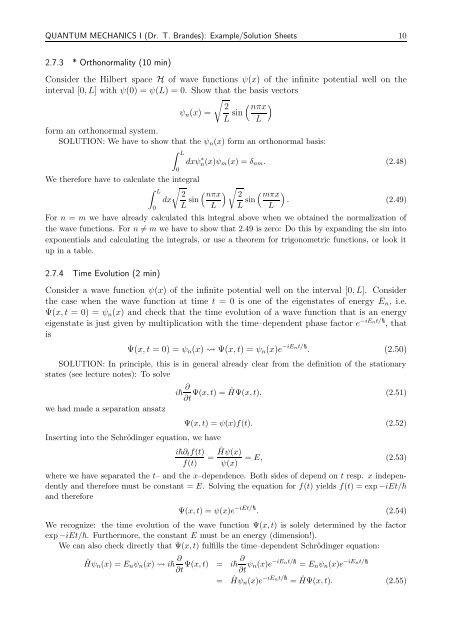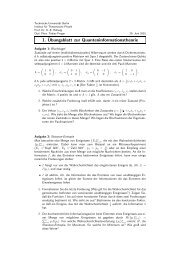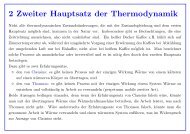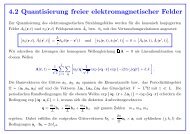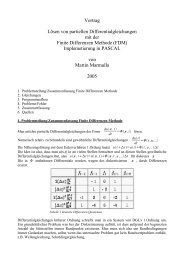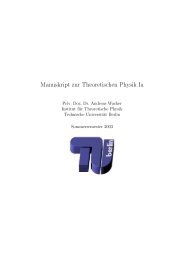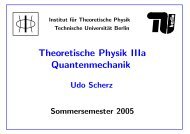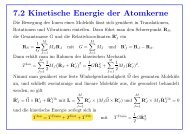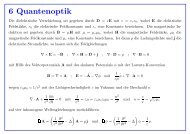1.1 The Radiation Laws and the Birth of Quantum Mechanics
1.1 The Radiation Laws and the Birth of Quantum Mechanics
1.1 The Radiation Laws and the Birth of Quantum Mechanics
Create successful ePaper yourself
Turn your PDF publications into a flip-book with our unique Google optimized e-Paper software.
QUANTUM MECHANICS I (Dr. T. Br<strong>and</strong>es): Example/Solution Sheets 10<br />
2.7.3 * Orthonormality (10 min)<br />
Consider <strong>the</strong> Hilbert space H <strong>of</strong> wave functions ψ(x) <strong>of</strong> <strong>the</strong> infinite potential well on <strong>the</strong><br />
interval [0, L] with ψ(0) = ψ(L) = 0. Show that <strong>the</strong> basis vectors<br />
√<br />
2<br />
( nπx<br />
)<br />
ψ n (x) =<br />
L sin L<br />
form an orthonormal system.<br />
SOLUTION: We have to show that <strong>the</strong> ψ n (x) form an orthonormal basis:<br />
0<br />
∫ L<br />
0<br />
dxψ ∗ n(x)ψ m (x) = δ nm . (2.48)<br />
We <strong>the</strong>refore have to calculate <strong>the</strong> integral<br />
∫ √ L 2<br />
( nπx<br />
) √<br />
dx<br />
L sin 2<br />
( mπx<br />
)<br />
L L sin . (2.49)<br />
L<br />
For n = m we have already calculated this integral above when we obtained <strong>the</strong> normalization <strong>of</strong><br />
<strong>the</strong> wave functions. For n ≠ m we have to show that 2.49 is zero: Do this by exp<strong>and</strong>ing <strong>the</strong> sin into<br />
exponentials <strong>and</strong> calculating <strong>the</strong> integrals, or use a <strong>the</strong>orem for trigonometric functions, or look it<br />
up in a table.<br />
2.7.4 Time Evolution (2 min)<br />
Consider a wave function ψ(x) <strong>of</strong> <strong>the</strong> infinite potential well on <strong>the</strong> interval [0, L]. Consider<br />
<strong>the</strong> case when <strong>the</strong> wave function at time t = 0 is one <strong>of</strong> <strong>the</strong> eigenstates <strong>of</strong> energy E n , i.e.<br />
Ψ(x, t = 0) = ψ n (x) <strong>and</strong> check that <strong>the</strong> time evolution <strong>of</strong> a wave function that is an energy<br />
eigenstate is just given by multiplication with <strong>the</strong> time–dependent phase factor e −iEnt/ , that<br />
is<br />
Ψ(x, t = 0) = ψ n (x) Ψ(x, t) = ψ n (x)e −iEnt/ . (2.50)<br />
SOLUTION: In principle, this is in general already clear from <strong>the</strong> definition <strong>of</strong> <strong>the</strong> stationary<br />
states (see lecture notes): To solve<br />
we had made a separation ansatz<br />
Inserting into <strong>the</strong> Schrödinger equation, we have<br />
i ∂ Ψ(x, t) = ĤΨ(x, t), (2.51)<br />
∂t<br />
Ψ(x, t) = ψ(x)f(t). (2.52)<br />
i∂ t f(t)<br />
f(t)<br />
= Ĥψ(x)<br />
ψ(x)<br />
= E, (2.53)<br />
where we have separated <strong>the</strong> t– <strong>and</strong> <strong>the</strong> x–dependence. Both sides <strong>of</strong> depend on t resp. x independently<br />
<strong>and</strong> <strong>the</strong>refore must be constant = E. Solving <strong>the</strong> equation for f(t) yields f(t) = exp −iEt/<br />
<strong>and</strong> <strong>the</strong>refore<br />
Ψ(x, t) = ψ(x)e −iEt/ . (2.54)<br />
We recognize: <strong>the</strong> time evolution <strong>of</strong> <strong>the</strong> wave function Ψ(x, t) is solely determined by <strong>the</strong> factor<br />
exp −iEt/. Fur<strong>the</strong>rmore, <strong>the</strong> constant E must be an energy (dimension!).<br />
We can also check directly that Ψ(x, t) fulfills <strong>the</strong> time–dependent Schrödinger equation:<br />
Ĥψ n (x) = E n ψ n (x) i ∂ ∂t Ψ(x, t) = i ∂ ∂t ψ n(x)e −iEnt/ = E n ψ n (x)e −iEnt/<br />
= Ĥψ n(x)e −iEnt/ = ĤΨ(x, t). (2.55)


